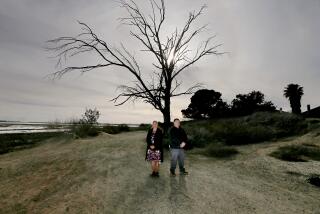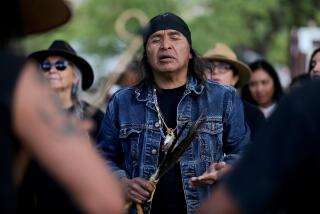Dig Transports Archeologists Into Prehistory, Accepted Fact Into Mystery
- Share via
IVOTUK, Alaska — It’s not quite Indiana Jones and the Mesa of Doom, but archeologists at this stark Arctic dig do get to pack guns and dispatch hordes of nasty assailants.
The hordes are the incessant summer mosquitoes that buzz around the mesa that Paleoindians used as a hunting lookout nearly 12,000 years ago. And researchers carry shotguns in case bears interrupt their digging.
Hardships almost always come with the turf for archeologists in the field, but the rigors of working at the mesa site 150 miles above the Arctic Circle are especially difficult.
“It is one of the most challenging areas to do archeological work,” said Stephen Durand, a researcher from East New Mexico University who has been mapping the site. “In the Southwest, you have to deal with the heat, but you have enough water and better access to supplies. Sometimes the local people there don’t like what you’re doing. They’re the ones carrying shotguns.”
Around the mesa, long, fierce winters limit digging to summer, when temperatures still can dip below freezing. Summer’s perpetual daylight allows for long digging hours but can play games with the sleep patterns of researchers unused to 24 hours of light for two months at a stretch.
The terrain is pocked by peat and tussock, thick, hard clumps of grass and other vegetation that make travel a bit like walking through fields of bowling balls spaced six inches apart. Moving supplies in and out must be done by planes that land at the Ivotuk airstrip a few miles away or helicopters that can land at the tent camp where researchers live just below the mesa.
“It’s tough living here,” said Richard Reanier, an archeologist from the University of Alaska Fairbanks and one of the lead researchers. “Cooking is hard, and walking to the creek and dragging water back, it’s hard to get in eight hours of work.”
Researchers use open-air latrines. Two tents house the camp’s smoky kitchen and an office equipped with satellite phones and fax machines. There are no neighbors to speak of; the nearest sizable town is Barrow, 200 miles north, while the closest large city is Fairbanks, 350 miles southeast.
“It’s like going back in time,” said Chris Wenzel, an East New Mexico University graduate student who has worked at the site for three summers. “There’s no roads, you don’t see any suburbs. When I’m up there excavating and look around, I’m seeing the same scenery as they did 10,000 years ago.”
The site itself would fit well in one of Steven Spielberg’s movies about the intrepid Indiana Jones. The mesa is a harsh hunk of igneous rock rising 200 feet above a fairly flat landscape dotted with softer, rounder hills.
From atop the mesa, ancient hunters could spy bison, mammoths and other prey for miles around.
“You get a view of 100 square miles from up here,” said Michael Kunz, a U.S. Bureau of Land Management archeologist who discovered the first artifacts on the mesa in 1978 and heads the excavations. “It was a natural lookout. You could stand here and do a 360 and not miss a thing.”
The dig stirred talk in archeological circles when Kunz and his colleagues announced their discoveries in 1993. It was the first solid evidence of early habitation in Alaska by Paleoindians, akin to those who lived in the Great Plains and the Southwest.
The main artifacts unearthed on the mesa have been flaked-stone spearheads resembling the Clovis projectile points found at Southwest excavations of Paleoindians who lived 10,000 to 12,000 years ago. Similar artifacts had been discovered at other sites in Alaska, but their age could not be accurately dated.
Using charcoal from the remnants of campfires on the mesa, Kunz’s team found two separate periods of occupation by Paleoindians, from 11,700 to 11,200 years ago and again from 10,200 to 9,700 years ago.
Those dates would make Paleoindian culture in Alaska contemporaneous with similar societies previously thought to have developed independently in the southwestern United States.
The stone weapons are unlike anything used by Eskimos who moved into northern Alaska later across the Bering Sea land bridge from Siberia.
The find presents intriguing new theories: Did Paleoindian culture and technology actually develop in the Far North and migrate south? Did bands of Paleoindians migrate back to Alaska from the Southwest? Or is there as yet undiscovered evidence of Paleoindian habitation in Siberia or on the land bridge now buried at the bottom of the sea?
“Under the old theories, we should have the oldest people in Alaska, then progressively moving south,” Kunz said. “That isn’t what we found happening, though. This has taken a lot of clear water and muddied it.”
The hunters who stood watch on the mesa were highly mobile, following the herds of mammals. No evidence has been found indicating the site was used by later immigrants.
The mesa dwellers may have abandoned the site because of abrupt climate changes during the last Ice Age. As the land changed gradually to the broken terrain that surrounds the mesa today, game herds probably moved on to better pastures, with the mesa hunters following.
“The people and their prey, everybody left town,” said Daniel Mann, a University of Alaska Fairbanks geologist.
With no later habitation to disturb them, the mesa’s artifacts were left intact, buried within a few inches of the surface.
“When you hike up, you see the millennia kind of peeling away and it’s 11,000 years ago,” said Deborah Williams, who heads the Alaska office of the U.S. Interior Department that oversees the Bureau of Land Management. “It’s ancient times, unless you look that way,” toward the researchers’ base camp of yellow dome tents.
This summer marked the end of an intensive five-year excavation of the site. Still to come is laboratory work on materials dug up at the site, along with a lot of theorizing on how the mesa hunters fit into the ancient picture of human migration.
“As archeologists, you’re kind of like a detective, except you’re on the scene of the crime 12,000 years after the fact instead of two days later,” Kunz said. “I like the mystery.”
More to Read
Sign up for Essential California
The most important California stories and recommendations in your inbox every morning.
You may occasionally receive promotional content from the Los Angeles Times.













